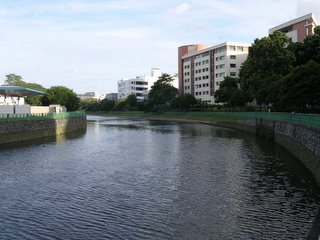For the past 1 year, I have been going to Bishan St 14 twice a week to fetch my daughter from her Japanese Language class at the Ministry of Education Language Centre. All this time, I didn’t know that just behind the school runs a canal we used to call the Say Kai Hor or ‘Dead Chicken River’ in Cantonese (死鸡河). As I explained in an earlier blog, this was the name we gave to the section of the Kallang River which ran through our kampong in Lorong Kinchir, off Lorong Chuan. Many of the village folks (not our family, I must declare) used to discard dead animals like chickens, dogs and even pigs into the river. The resulting stench was sometimes so strong that whenever we walked or cycled past the river, we had to hold our breaths. Sometimes, when the tide was low, you could even see the maggots crawling all over the carcasses, a sight that even we kampong kids found it difficult to stomache.
But today, this dirty river has been completely transformed into a clean, well-maintained, tree-lined canal with a jogging-cum-cycling track along it, linking the Bishan Park to Potong Pasir.

This is the Bishan Park-Braddell Road Section

This is the Braddell Road-Potong Pasir Section

In a sense, this transformation is a reflection of the progress our country has made since its independence. Although we are a small, young country with no Taj Mahals and Great Walls to boast about, I think Singaporeans, especially my generation, can take some pride that we have simple ‘wonders’ like this canal to pass on as a heritage to our children.








13 comments:
For a moment, I thought you're blogging about the Bird Flu! Or that you found some dead chickens with the much feared H5N1 virus!
So Chun See, would you agree that tearing down our buildings (READ: Destroying some part of our heritage) in the name of progress is not necessarily a bad thing?
Haha - I deliberately chose this misleading title.
I am going to complain to NHB for not preserving the Dead Chicken River as a national heritage site.
My young man's school is in the vicinity of Bishan too. We also cycled in Bishan Park several times before. But we never pay much attention to the canal there. Is this canal the same one that we cross when accessing Bishan Park from the open air carpark?
Hehe.. a flamed.. I mean famed blogger like you need not purposely choose a misleading title, u know. Pulling your leg again as usual, Chun See.
I also thought you are going to blog about bird flu too...
Victor, Yes it is. But not sure why they dam up the river at the Braddell Rd section so that this side has very little water; as u can see from the photos.
Oh so it's the same Kallang River eh? Why did they dam up the river at Braddell Road section? Did you mention that the river later flows through Potong Pasir? Hmm... do you think it could be something to do with the ward being an opposition one? Haha.
We should not forget that the 'Dead Chicken Canal' was the product of irresponsible kampong folks at that time. It reflects that some people then and even now do not respect the environment.
Looks clean enough to go kayaking in!
Thanks for sharing this interesting bit of Spore history. They should have kept the name as a reminder.
I think many of the kampong folks at that were ignorant and were not aware of the consequences of their action.
Actually the Kallang River, near the Kallang River mouth section is used for kayaking and water skiing for a number of years already. At the moment they are in the process of damming up the Marina Bay and make into a world class kayaking area to host the 2010 world championships. That's why many of the kayaking trg is now held at McRitchie Reservoir instead.
Many kampongs had their own abattoirs at that time. Sometime sick pigs were being slaughtered and sold in the open market. Apparently people then had strong immune systems - no report of wide-spread epidemics. It is quite scary to think of it now.
This river was briefly mentioned in my university lecture, really interesting piece of history that shows how Singapore has really developed their waterways from being very polluted to clear and actually flowing rivers.
Post a Comment